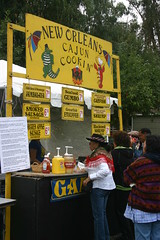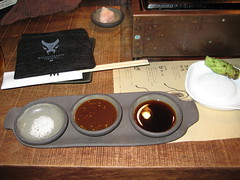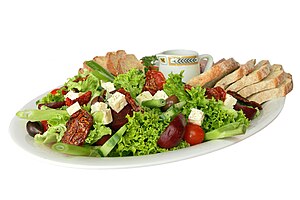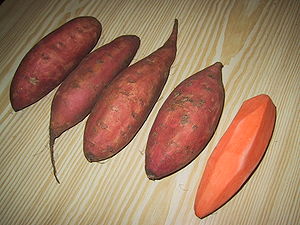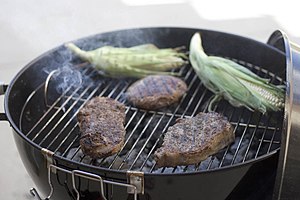If you've ever thought how nice it would be to cook Chinese food at home, but had no idea where to start, you may want to check out a cookbook by Ken Hom. Ken is the the USA-born chef of Cantonese parents, and is well-known for making Chinese cooking accessible to beginning cooks all over the world.
Ken presents Chinese cuisine in such an easily-understandable way, demonstrating techniques and suggesting alternative ingredients should the originals not be available in your local supermarket. The book which heads the series,
Ken Hom's Chinese Cookery
, may well become your Bible of Chinese cooking!
To help you on your way to cooking Chinese food at home, I’m going to briefly describe the basic equipment, ingredients and techniques which you need to know so that you can produce some simple and tasty dishes. I hope you enjoy the article and that it inspires you to get cooking!
Equipment
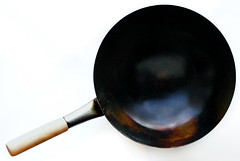 Prepared Wok (Photo credit: FotoosVanRobin)
Prepared Wok (Photo credit: FotoosVanRobin)Although there are many implements and pieces of equipment you can buy to start cooking your own Chinese food, you really only need a good knife or two and a wok. Woks come in all shapes and sizes, they can be non-stick, flat-bottomed, they can even be electric these days but I still prefer my old carbon steel wok with it’s rounded bottom and one wooden handle. This is a Pau wok. These are readily available in Chinese supermarkets and are much less expensive than other varieties.
There is one important task though, before you will be ready to cook with such a wok and that is to
season it.
Seasoning Instructions:
- First, you will need to scrub it with a cream cleaner to remove any residues of machine oil and dry it carefully.
- Put the wok over low heat.
- Rub the inside of the wok with two tablespoons of cooking oil using a kitchen towel.
- Let the wok heat slowly for 10 to 15 minutes then wipe the inside with paper towels. The paper will come away black.
- Carry on coating, heating and cleaning off until the kitchen towel comes away clean. Your wok is now ready to use.
- After use, wash ONLY in water without detergent and dry thoroughly over a low heat. You may also apply a little oil if you wish. This should prevent the wok from rusting but if it does develop rust, just scrub and season again.
As well as the wok, you will need a wok stand, particularly if you have an electric stove. This keeps the wok stable if you are using it for braising or deep frying.
You will also need something to stir with – any spatula or slotted spoon will do – metal for an un-coated metal wok and plastic or wooden for a non-stick wok.
Ingredients
Before you rush out and buy up the whole Chinese section at the supermarket, bear in mind that some ingredients don’t keep well if left unused. Just select something simple from your chosen cookbook and buy the things that you need for that - then you can expand your selection as you progress through different dishes.
Some common store-cupboard ingredients that you will almost certainly need are dark and light soy sauce, some sort of cooking oil and sesame oil, cornflour/cornstarch, and rice wine or sherry.
Techniques
Stir-Frying
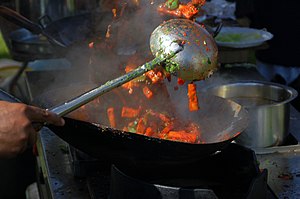 Image via Wikipedia
Image via WikipediaThe most well known Chinese cooking technique is stir-frying. This is where your wok comes into its own as it’s shape and size (at least 14 inches diameter with deep sides) is ideal for quick cooking.
The secret to successful stir-frying is to have all your ingredients ready in advance.
Meat should be cut according to the recipe but normally in thin strips. Vegetables likewise but in any event should be of similar shapes and sizes to ensure even cooking. Long thin vegetables such as spring onions, carrots or asparagus are often cut on the diagonal so that more surface area is exposed for quicker cooking. Measure out sauce ingredients - check the recipe - if they are all added to the dish at the same time, you can put them all in one small bowl. If cornstarch is included, don’t forget to give it a good stir before adding to the other food.
Once you have everything prepared, heat your wok until it is very hot then add oil and using your chosen stirring implement ensure that the oil is evenly distributed over the surface of the wok. Before you add your ingredients, the wok should be so hot that it is almost smoking - this will prevent the food from being greasy. The exception to this is if you are flavoring your oil with garlic, chilli, spring onions, ginger or salt - these will burn if the oil is too hot.
Now add your other ingredients in the order stated in the recipe and toss them over the surface of the wok ensuring that nothing rests in one place for too long and moving the food from the center of the wok to the sides. I suggest that you wear an apron or other protective clothing for this operation as the food often spits due to the high temperature it is cooked at.
Deep Frying
You can use your wok for deep frying but be very careful that it is safely balanced on its stand. Under no circumstances leave it unattended. Deep frying in a wok uses less oil than a deep fryer or saucepan but you may find these safer and easier to use.
 Image via Wikipedia
Image via WikipediaWhen deep frying, make sure that the oil is hot enough before adding ingredients or the food will end up very greasy. Test it by dropping in a small piece of prepared food or a cube of bread. If the oil bubbles up around what you dropped in then it’s hot enough.
Make sure that food to be deep fried is dried thoroughly on kitchen paper or drained of its marinade before cooking otherwise it will spit.
Shallow Frying
This is the same as the Western technique. Fry food on one side, then the other and drain off any excess oil before adding sauce ingredients. A normal frying pan is fine for this.
Steaming
Steaming is widely used in Chinese cookery. You can use a bamboo steamer in a wok, a heat-proof plate placed on a rack in a wok or other large pan or you can use a normal European steamer.
If using a bamboo steamer or plate in a wok, bring about 2 inches of water to a simmer. Put your rack into the wok (if the bamboo steamer is big enough and will sit on the sides of the wok without being in the water, you don’t need a rack) and balance your plate or steamer of food on it. Put the lid on your steamer or wok and check occasionally to see if the water needs topping up (use water which is already hot).
Whichever method you use, make sure that the food is above the water level and isn’t getting wet.
Braising
As with Western cooking, braising is used for tougher cuts of meat and involves gentle cooking of meat and/or vegetables in flavored stock. Red-braising is the technique where food is braised in a dark liquid such as soy sauce which gives the food a red/brown color. This type of braising sauce can be frozen and re-used.
Hopefully this article gives you a good overview for getting started with Chinese cooking. I've also included a couple of resources to check out below, including Ken Hom's book. And be sure to check back later this week when we will get into a bit of regional Chinese cuisine, and also share a tasty recipe!
Chinese Cooking Resources:
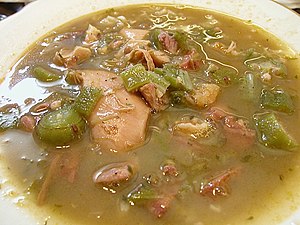 Image via WikipediaRose's Cajun Chicken & Ham Gumbo
Image via WikipediaRose's Cajun Chicken & Ham Gumbo
